Organisation Behaviour Essay: Exploring Key Concepts and Challenges
VerifiedAdded on 2020/02/19
|6
|2149
|1678
Essay
AI Summary
This essay provides a comprehensive overview of organisation behaviour, examining the behaviours of individuals within a workplace setting. It explores the multifaceted nature of employee attitudes, job satisfaction, and organisational commitment, highlighting their interdependencies and impact on overall performance. The essay delves into key contributing disciplines like psychology and sociology, illustrating how theories from these fields are applied to understand and influence workplace dynamics. It discusses various theories, including trait theory, Maslow's hierarchy of needs, and Vroom's expectancy theory, providing a framework for understanding employee motivation and behaviour. Furthermore, the essay addresses the challenges of globalisation, managing a diverse workforce, empowering employees, and fostering innovation. The conclusion emphasizes the complex relationship between attitude and behaviour, and the importance of addressing these challenges to maintain positive organisational behaviour. The essay also references several research papers and articles to support its arguments.
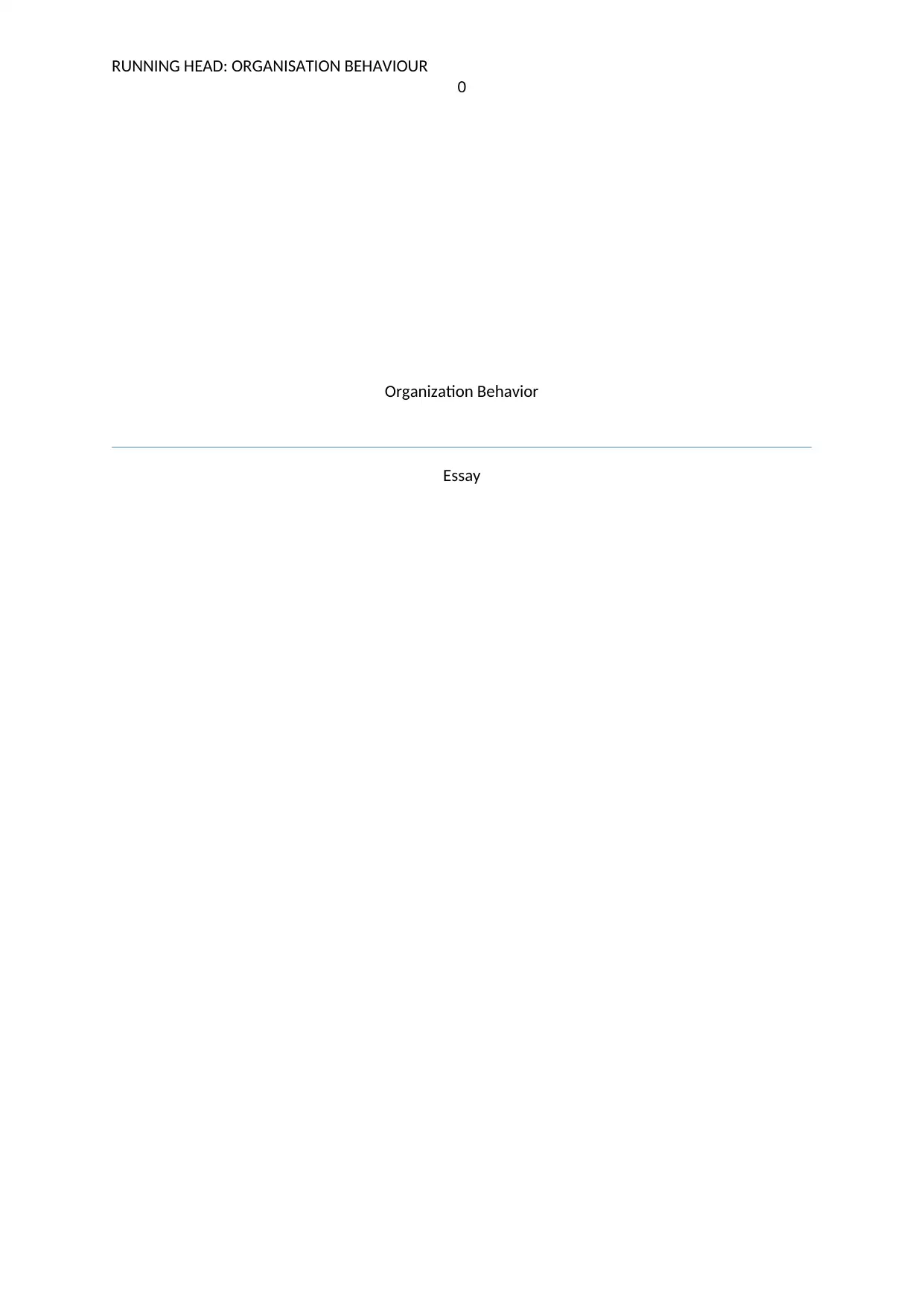
RUNNING HEAD: ORGANISATION BEHAVIOUR
0
Organization Behavior
Essay
0
Organization Behavior
Essay
Paraphrase This Document
Need a fresh take? Get an instant paraphrase of this document with our AI Paraphraser
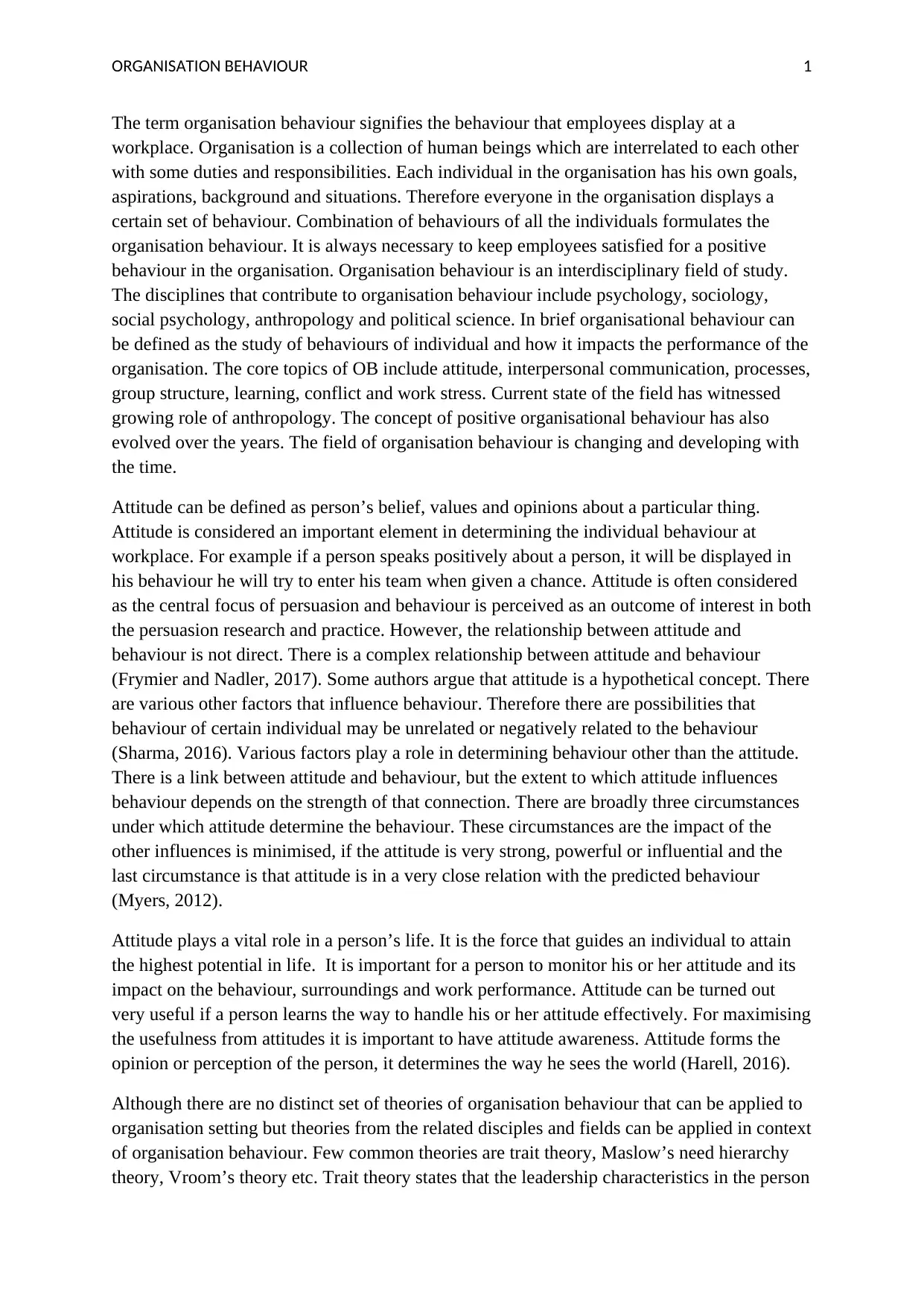
ORGANISATION BEHAVIOUR 1
The term organisation behaviour signifies the behaviour that employees display at a
workplace. Organisation is a collection of human beings which are interrelated to each other
with some duties and responsibilities. Each individual in the organisation has his own goals,
aspirations, background and situations. Therefore everyone in the organisation displays a
certain set of behaviour. Combination of behaviours of all the individuals formulates the
organisation behaviour. It is always necessary to keep employees satisfied for a positive
behaviour in the organisation. Organisation behaviour is an interdisciplinary field of study.
The disciplines that contribute to organisation behaviour include psychology, sociology,
social psychology, anthropology and political science. In brief organisational behaviour can
be defined as the study of behaviours of individual and how it impacts the performance of the
organisation. The core topics of OB include attitude, interpersonal communication, processes,
group structure, learning, conflict and work stress. Current state of the field has witnessed
growing role of anthropology. The concept of positive organisational behaviour has also
evolved over the years. The field of organisation behaviour is changing and developing with
the time.
Attitude can be defined as person’s belief, values and opinions about a particular thing.
Attitude is considered an important element in determining the individual behaviour at
workplace. For example if a person speaks positively about a person, it will be displayed in
his behaviour he will try to enter his team when given a chance. Attitude is often considered
as the central focus of persuasion and behaviour is perceived as an outcome of interest in both
the persuasion research and practice. However, the relationship between attitude and
behaviour is not direct. There is a complex relationship between attitude and behaviour
(Frymier and Nadler, 2017). Some authors argue that attitude is a hypothetical concept. There
are various other factors that influence behaviour. Therefore there are possibilities that
behaviour of certain individual may be unrelated or negatively related to the behaviour
(Sharma, 2016). Various factors play a role in determining behaviour other than the attitude.
There is a link between attitude and behaviour, but the extent to which attitude influences
behaviour depends on the strength of that connection. There are broadly three circumstances
under which attitude determine the behaviour. These circumstances are the impact of the
other influences is minimised, if the attitude is very strong, powerful or influential and the
last circumstance is that attitude is in a very close relation with the predicted behaviour
(Myers, 2012).
Attitude plays a vital role in a person’s life. It is the force that guides an individual to attain
the highest potential in life. It is important for a person to monitor his or her attitude and its
impact on the behaviour, surroundings and work performance. Attitude can be turned out
very useful if a person learns the way to handle his or her attitude effectively. For maximising
the usefulness from attitudes it is important to have attitude awareness. Attitude forms the
opinion or perception of the person, it determines the way he sees the world (Harell, 2016).
Although there are no distinct set of theories of organisation behaviour that can be applied to
organisation setting but theories from the related disciples and fields can be applied in context
of organisation behaviour. Few common theories are trait theory, Maslow’s need hierarchy
theory, Vroom’s theory etc. Trait theory states that the leadership characteristics in the person
The term organisation behaviour signifies the behaviour that employees display at a
workplace. Organisation is a collection of human beings which are interrelated to each other
with some duties and responsibilities. Each individual in the organisation has his own goals,
aspirations, background and situations. Therefore everyone in the organisation displays a
certain set of behaviour. Combination of behaviours of all the individuals formulates the
organisation behaviour. It is always necessary to keep employees satisfied for a positive
behaviour in the organisation. Organisation behaviour is an interdisciplinary field of study.
The disciplines that contribute to organisation behaviour include psychology, sociology,
social psychology, anthropology and political science. In brief organisational behaviour can
be defined as the study of behaviours of individual and how it impacts the performance of the
organisation. The core topics of OB include attitude, interpersonal communication, processes,
group structure, learning, conflict and work stress. Current state of the field has witnessed
growing role of anthropology. The concept of positive organisational behaviour has also
evolved over the years. The field of organisation behaviour is changing and developing with
the time.
Attitude can be defined as person’s belief, values and opinions about a particular thing.
Attitude is considered an important element in determining the individual behaviour at
workplace. For example if a person speaks positively about a person, it will be displayed in
his behaviour he will try to enter his team when given a chance. Attitude is often considered
as the central focus of persuasion and behaviour is perceived as an outcome of interest in both
the persuasion research and practice. However, the relationship between attitude and
behaviour is not direct. There is a complex relationship between attitude and behaviour
(Frymier and Nadler, 2017). Some authors argue that attitude is a hypothetical concept. There
are various other factors that influence behaviour. Therefore there are possibilities that
behaviour of certain individual may be unrelated or negatively related to the behaviour
(Sharma, 2016). Various factors play a role in determining behaviour other than the attitude.
There is a link between attitude and behaviour, but the extent to which attitude influences
behaviour depends on the strength of that connection. There are broadly three circumstances
under which attitude determine the behaviour. These circumstances are the impact of the
other influences is minimised, if the attitude is very strong, powerful or influential and the
last circumstance is that attitude is in a very close relation with the predicted behaviour
(Myers, 2012).
Attitude plays a vital role in a person’s life. It is the force that guides an individual to attain
the highest potential in life. It is important for a person to monitor his or her attitude and its
impact on the behaviour, surroundings and work performance. Attitude can be turned out
very useful if a person learns the way to handle his or her attitude effectively. For maximising
the usefulness from attitudes it is important to have attitude awareness. Attitude forms the
opinion or perception of the person, it determines the way he sees the world (Harell, 2016).
Although there are no distinct set of theories of organisation behaviour that can be applied to
organisation setting but theories from the related disciples and fields can be applied in context
of organisation behaviour. Few common theories are trait theory, Maslow’s need hierarchy
theory, Vroom’s theory etc. Trait theory states that the leadership characteristics in the person
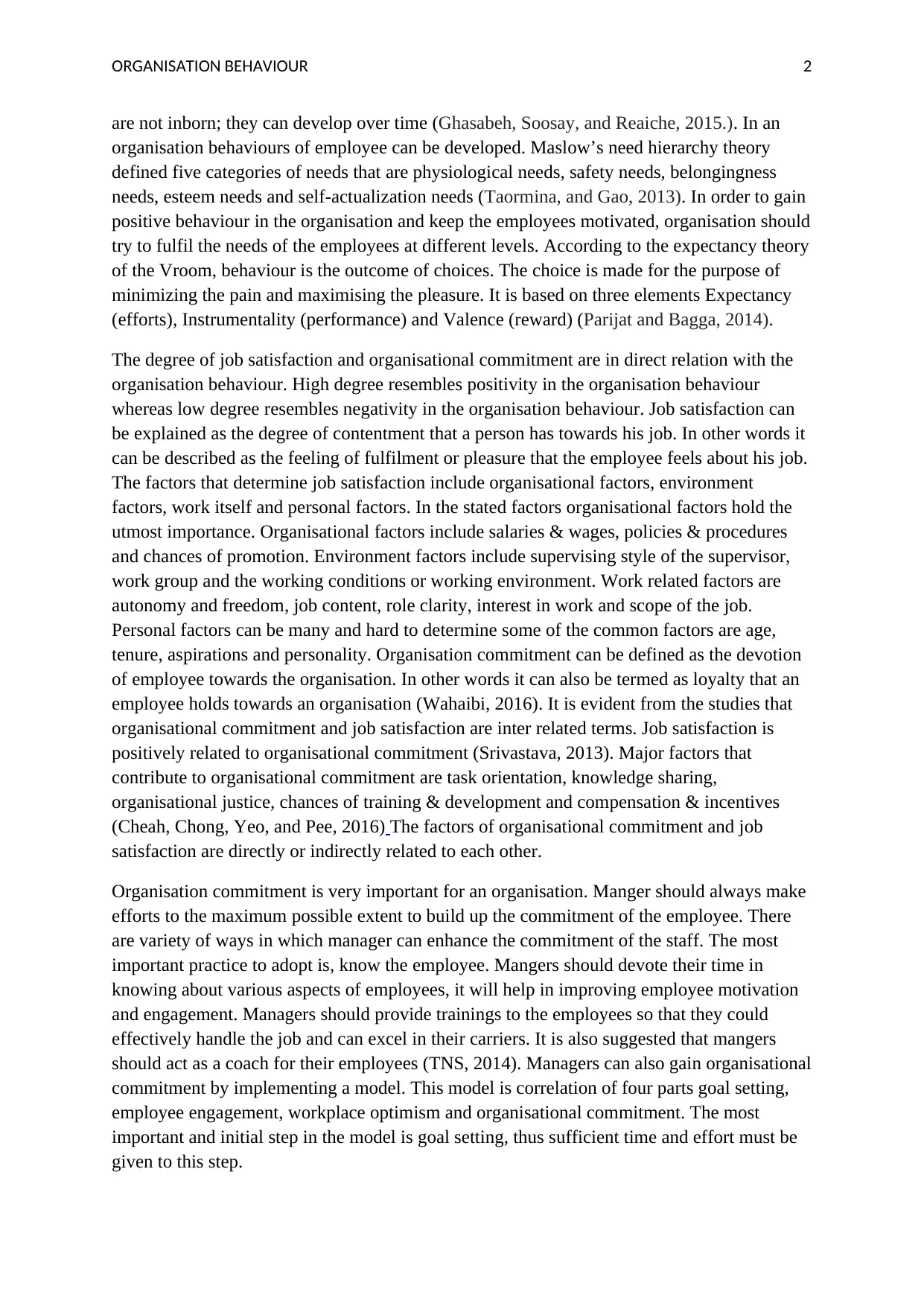
ORGANISATION BEHAVIOUR 2
are not inborn; they can develop over time (Ghasabeh, Soosay, and Reaiche, 2015.). In an
organisation behaviours of employee can be developed. Maslow’s need hierarchy theory
defined five categories of needs that are physiological needs, safety needs, belongingness
needs, esteem needs and self-actualization needs (Taormina, and Gao, 2013). In order to gain
positive behaviour in the organisation and keep the employees motivated, organisation should
try to fulfil the needs of the employees at different levels. According to the expectancy theory
of the Vroom, behaviour is the outcome of choices. The choice is made for the purpose of
minimizing the pain and maximising the pleasure. It is based on three elements Expectancy
(efforts), Instrumentality (performance) and Valence (reward) (Parijat and Bagga, 2014).
The degree of job satisfaction and organisational commitment are in direct relation with the
organisation behaviour. High degree resembles positivity in the organisation behaviour
whereas low degree resembles negativity in the organisation behaviour. Job satisfaction can
be explained as the degree of contentment that a person has towards his job. In other words it
can be described as the feeling of fulfilment or pleasure that the employee feels about his job.
The factors that determine job satisfaction include organisational factors, environment
factors, work itself and personal factors. In the stated factors organisational factors hold the
utmost importance. Organisational factors include salaries & wages, policies & procedures
and chances of promotion. Environment factors include supervising style of the supervisor,
work group and the working conditions or working environment. Work related factors are
autonomy and freedom, job content, role clarity, interest in work and scope of the job.
Personal factors can be many and hard to determine some of the common factors are age,
tenure, aspirations and personality. Organisation commitment can be defined as the devotion
of employee towards the organisation. In other words it can also be termed as loyalty that an
employee holds towards an organisation (Wahaibi, 2016). It is evident from the studies that
organisational commitment and job satisfaction are inter related terms. Job satisfaction is
positively related to organisational commitment (Srivastava, 2013). Major factors that
contribute to organisational commitment are task orientation, knowledge sharing,
organisational justice, chances of training & development and compensation & incentives
(Cheah, Chong, Yeo, and Pee, 2016) The factors of organisational commitment and job
satisfaction are directly or indirectly related to each other.
Organisation commitment is very important for an organisation. Manger should always make
efforts to the maximum possible extent to build up the commitment of the employee. There
are variety of ways in which manager can enhance the commitment of the staff. The most
important practice to adopt is, know the employee. Mangers should devote their time in
knowing about various aspects of employees, it will help in improving employee motivation
and engagement. Managers should provide trainings to the employees so that they could
effectively handle the job and can excel in their carriers. It is also suggested that mangers
should act as a coach for their employees (TNS, 2014). Managers can also gain organisational
commitment by implementing a model. This model is correlation of four parts goal setting,
employee engagement, workplace optimism and organisational commitment. The most
important and initial step in the model is goal setting, thus sufficient time and effort must be
given to this step.
are not inborn; they can develop over time (Ghasabeh, Soosay, and Reaiche, 2015.). In an
organisation behaviours of employee can be developed. Maslow’s need hierarchy theory
defined five categories of needs that are physiological needs, safety needs, belongingness
needs, esteem needs and self-actualization needs (Taormina, and Gao, 2013). In order to gain
positive behaviour in the organisation and keep the employees motivated, organisation should
try to fulfil the needs of the employees at different levels. According to the expectancy theory
of the Vroom, behaviour is the outcome of choices. The choice is made for the purpose of
minimizing the pain and maximising the pleasure. It is based on three elements Expectancy
(efforts), Instrumentality (performance) and Valence (reward) (Parijat and Bagga, 2014).
The degree of job satisfaction and organisational commitment are in direct relation with the
organisation behaviour. High degree resembles positivity in the organisation behaviour
whereas low degree resembles negativity in the organisation behaviour. Job satisfaction can
be explained as the degree of contentment that a person has towards his job. In other words it
can be described as the feeling of fulfilment or pleasure that the employee feels about his job.
The factors that determine job satisfaction include organisational factors, environment
factors, work itself and personal factors. In the stated factors organisational factors hold the
utmost importance. Organisational factors include salaries & wages, policies & procedures
and chances of promotion. Environment factors include supervising style of the supervisor,
work group and the working conditions or working environment. Work related factors are
autonomy and freedom, job content, role clarity, interest in work and scope of the job.
Personal factors can be many and hard to determine some of the common factors are age,
tenure, aspirations and personality. Organisation commitment can be defined as the devotion
of employee towards the organisation. In other words it can also be termed as loyalty that an
employee holds towards an organisation (Wahaibi, 2016). It is evident from the studies that
organisational commitment and job satisfaction are inter related terms. Job satisfaction is
positively related to organisational commitment (Srivastava, 2013). Major factors that
contribute to organisational commitment are task orientation, knowledge sharing,
organisational justice, chances of training & development and compensation & incentives
(Cheah, Chong, Yeo, and Pee, 2016) The factors of organisational commitment and job
satisfaction are directly or indirectly related to each other.
Organisation commitment is very important for an organisation. Manger should always make
efforts to the maximum possible extent to build up the commitment of the employee. There
are variety of ways in which manager can enhance the commitment of the staff. The most
important practice to adopt is, know the employee. Mangers should devote their time in
knowing about various aspects of employees, it will help in improving employee motivation
and engagement. Managers should provide trainings to the employees so that they could
effectively handle the job and can excel in their carriers. It is also suggested that mangers
should act as a coach for their employees (TNS, 2014). Managers can also gain organisational
commitment by implementing a model. This model is correlation of four parts goal setting,
employee engagement, workplace optimism and organisational commitment. The most
important and initial step in the model is goal setting, thus sufficient time and effort must be
given to this step.
⊘ This is a preview!⊘
Do you want full access?
Subscribe today to unlock all pages.

Trusted by 1+ million students worldwide
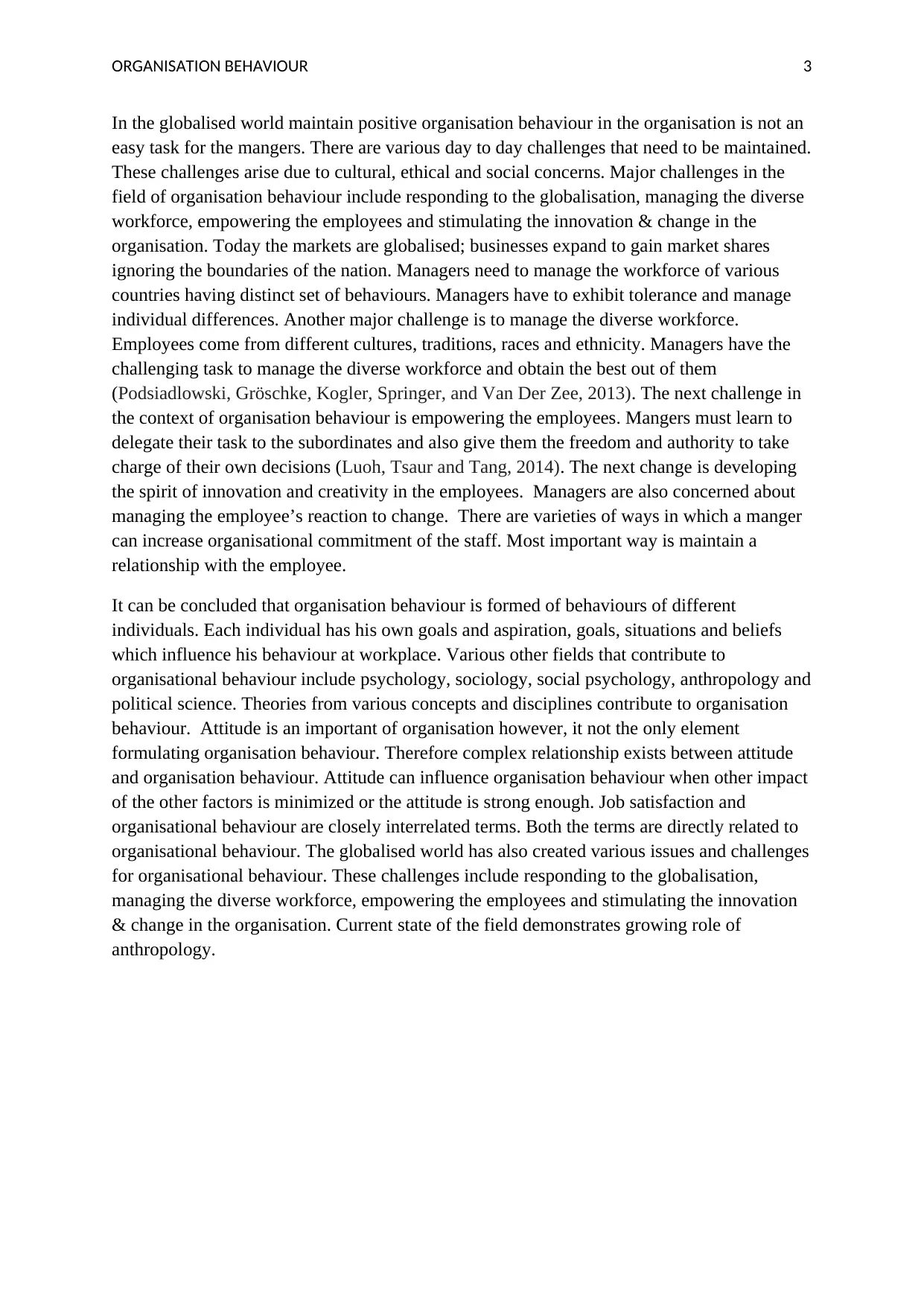
ORGANISATION BEHAVIOUR 3
In the globalised world maintain positive organisation behaviour in the organisation is not an
easy task for the mangers. There are various day to day challenges that need to be maintained.
These challenges arise due to cultural, ethical and social concerns. Major challenges in the
field of organisation behaviour include responding to the globalisation, managing the diverse
workforce, empowering the employees and stimulating the innovation & change in the
organisation. Today the markets are globalised; businesses expand to gain market shares
ignoring the boundaries of the nation. Managers need to manage the workforce of various
countries having distinct set of behaviours. Managers have to exhibit tolerance and manage
individual differences. Another major challenge is to manage the diverse workforce.
Employees come from different cultures, traditions, races and ethnicity. Managers have the
challenging task to manage the diverse workforce and obtain the best out of them
(Podsiadlowski, Gröschke, Kogler, Springer, and Van Der Zee, 2013). The next challenge in
the context of organisation behaviour is empowering the employees. Mangers must learn to
delegate their task to the subordinates and also give them the freedom and authority to take
charge of their own decisions (Luoh, Tsaur and Tang, 2014). The next change is developing
the spirit of innovation and creativity in the employees. Managers are also concerned about
managing the employee’s reaction to change. There are varieties of ways in which a manger
can increase organisational commitment of the staff. Most important way is maintain a
relationship with the employee.
It can be concluded that organisation behaviour is formed of behaviours of different
individuals. Each individual has his own goals and aspiration, goals, situations and beliefs
which influence his behaviour at workplace. Various other fields that contribute to
organisational behaviour include psychology, sociology, social psychology, anthropology and
political science. Theories from various concepts and disciplines contribute to organisation
behaviour. Attitude is an important of organisation however, it not the only element
formulating organisation behaviour. Therefore complex relationship exists between attitude
and organisation behaviour. Attitude can influence organisation behaviour when other impact
of the other factors is minimized or the attitude is strong enough. Job satisfaction and
organisational behaviour are closely interrelated terms. Both the terms are directly related to
organisational behaviour. The globalised world has also created various issues and challenges
for organisational behaviour. These challenges include responding to the globalisation,
managing the diverse workforce, empowering the employees and stimulating the innovation
& change in the organisation. Current state of the field demonstrates growing role of
anthropology.
In the globalised world maintain positive organisation behaviour in the organisation is not an
easy task for the mangers. There are various day to day challenges that need to be maintained.
These challenges arise due to cultural, ethical and social concerns. Major challenges in the
field of organisation behaviour include responding to the globalisation, managing the diverse
workforce, empowering the employees and stimulating the innovation & change in the
organisation. Today the markets are globalised; businesses expand to gain market shares
ignoring the boundaries of the nation. Managers need to manage the workforce of various
countries having distinct set of behaviours. Managers have to exhibit tolerance and manage
individual differences. Another major challenge is to manage the diverse workforce.
Employees come from different cultures, traditions, races and ethnicity. Managers have the
challenging task to manage the diverse workforce and obtain the best out of them
(Podsiadlowski, Gröschke, Kogler, Springer, and Van Der Zee, 2013). The next challenge in
the context of organisation behaviour is empowering the employees. Mangers must learn to
delegate their task to the subordinates and also give them the freedom and authority to take
charge of their own decisions (Luoh, Tsaur and Tang, 2014). The next change is developing
the spirit of innovation and creativity in the employees. Managers are also concerned about
managing the employee’s reaction to change. There are varieties of ways in which a manger
can increase organisational commitment of the staff. Most important way is maintain a
relationship with the employee.
It can be concluded that organisation behaviour is formed of behaviours of different
individuals. Each individual has his own goals and aspiration, goals, situations and beliefs
which influence his behaviour at workplace. Various other fields that contribute to
organisational behaviour include psychology, sociology, social psychology, anthropology and
political science. Theories from various concepts and disciplines contribute to organisation
behaviour. Attitude is an important of organisation however, it not the only element
formulating organisation behaviour. Therefore complex relationship exists between attitude
and organisation behaviour. Attitude can influence organisation behaviour when other impact
of the other factors is minimized or the attitude is strong enough. Job satisfaction and
organisational behaviour are closely interrelated terms. Both the terms are directly related to
organisational behaviour. The globalised world has also created various issues and challenges
for organisational behaviour. These challenges include responding to the globalisation,
managing the diverse workforce, empowering the employees and stimulating the innovation
& change in the organisation. Current state of the field demonstrates growing role of
anthropology.
Paraphrase This Document
Need a fresh take? Get an instant paraphrase of this document with our AI Paraphraser
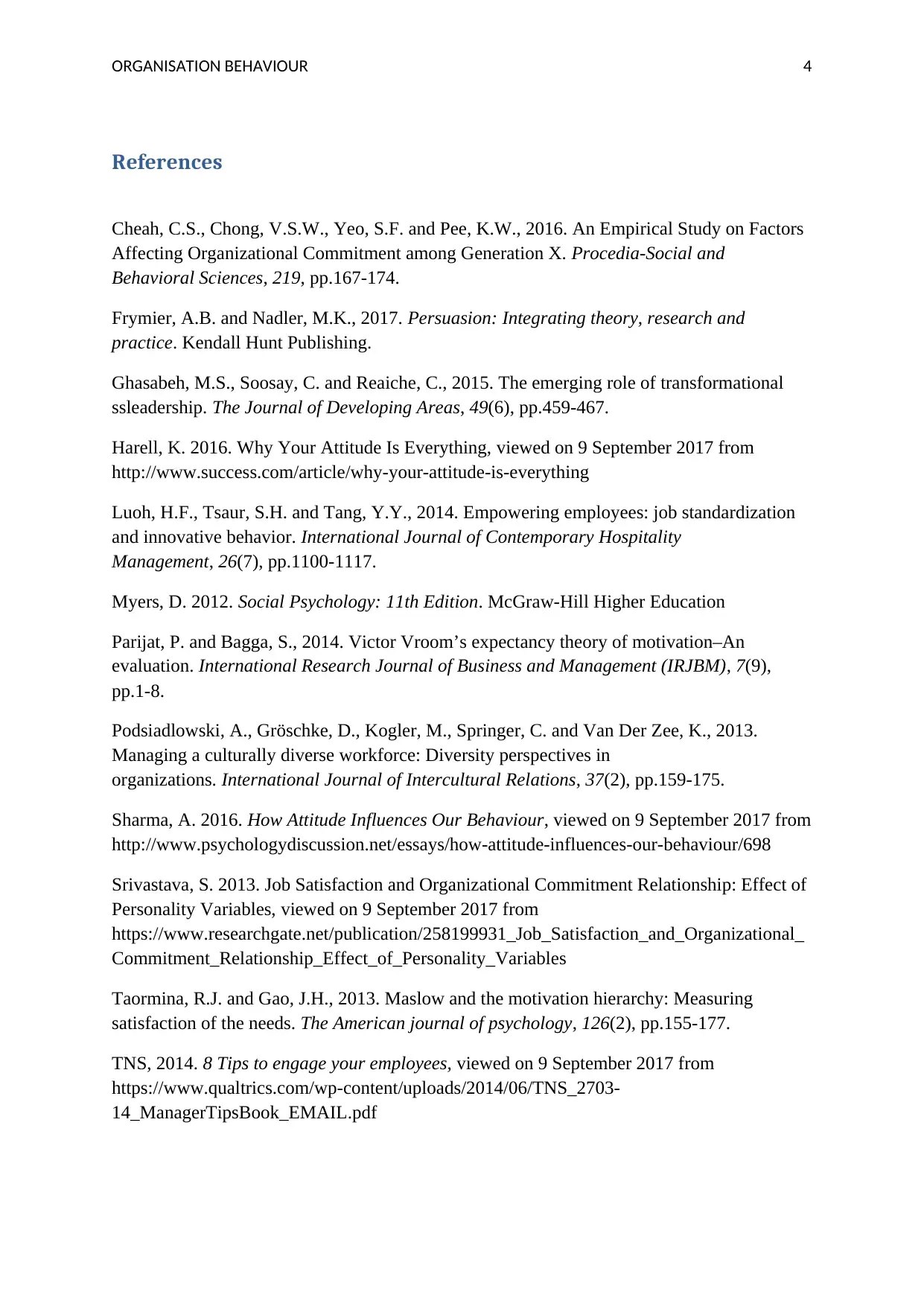
ORGANISATION BEHAVIOUR 4
References
Cheah, C.S., Chong, V.S.W., Yeo, S.F. and Pee, K.W., 2016. An Empirical Study on Factors
Affecting Organizational Commitment among Generation X. Procedia-Social and
Behavioral Sciences, 219, pp.167-174.
Frymier, A.B. and Nadler, M.K., 2017. Persuasion: Integrating theory, research and
practice. Kendall Hunt Publishing.
Ghasabeh, M.S., Soosay, C. and Reaiche, C., 2015. The emerging role of transformational
ssleadership. The Journal of Developing Areas, 49(6), pp.459-467.
Harell, K. 2016. Why Your Attitude Is Everything, viewed on 9 September 2017 from
http://www.success.com/article/why-your-attitude-is-everything
Luoh, H.F., Tsaur, S.H. and Tang, Y.Y., 2014. Empowering employees: job standardization
and innovative behavior. International Journal of Contemporary Hospitality
Management, 26(7), pp.1100-1117.
Myers, D. 2012. Social Psychology: 11th Edition. McGraw-Hill Higher Education
Parijat, P. and Bagga, S., 2014. Victor Vroom’s expectancy theory of motivation–An
evaluation. International Research Journal of Business and Management (IRJBM), 7(9),
pp.1-8.
Podsiadlowski, A., Gröschke, D., Kogler, M., Springer, C. and Van Der Zee, K., 2013.
Managing a culturally diverse workforce: Diversity perspectives in
organizations. International Journal of Intercultural Relations, 37(2), pp.159-175.
Sharma, A. 2016. How Attitude Influences Our Behaviour, viewed on 9 September 2017 from
http://www.psychologydiscussion.net/essays/how-attitude-influences-our-behaviour/698
Srivastava, S. 2013. Job Satisfaction and Organizational Commitment Relationship: Effect of
Personality Variables, viewed on 9 September 2017 from
https://www.researchgate.net/publication/258199931_Job_Satisfaction_and_Organizational_
Commitment_Relationship_Effect_of_Personality_Variables
Taormina, R.J. and Gao, J.H., 2013. Maslow and the motivation hierarchy: Measuring
satisfaction of the needs. The American journal of psychology, 126(2), pp.155-177.
TNS, 2014. 8 Tips to engage your employees, viewed on 9 September 2017 from
https://www.qualtrics.com/wp-content/uploads/2014/06/TNS_2703-
14_ManagerTipsBook_EMAIL.pdf
References
Cheah, C.S., Chong, V.S.W., Yeo, S.F. and Pee, K.W., 2016. An Empirical Study on Factors
Affecting Organizational Commitment among Generation X. Procedia-Social and
Behavioral Sciences, 219, pp.167-174.
Frymier, A.B. and Nadler, M.K., 2017. Persuasion: Integrating theory, research and
practice. Kendall Hunt Publishing.
Ghasabeh, M.S., Soosay, C. and Reaiche, C., 2015. The emerging role of transformational
ssleadership. The Journal of Developing Areas, 49(6), pp.459-467.
Harell, K. 2016. Why Your Attitude Is Everything, viewed on 9 September 2017 from
http://www.success.com/article/why-your-attitude-is-everything
Luoh, H.F., Tsaur, S.H. and Tang, Y.Y., 2014. Empowering employees: job standardization
and innovative behavior. International Journal of Contemporary Hospitality
Management, 26(7), pp.1100-1117.
Myers, D. 2012. Social Psychology: 11th Edition. McGraw-Hill Higher Education
Parijat, P. and Bagga, S., 2014. Victor Vroom’s expectancy theory of motivation–An
evaluation. International Research Journal of Business and Management (IRJBM), 7(9),
pp.1-8.
Podsiadlowski, A., Gröschke, D., Kogler, M., Springer, C. and Van Der Zee, K., 2013.
Managing a culturally diverse workforce: Diversity perspectives in
organizations. International Journal of Intercultural Relations, 37(2), pp.159-175.
Sharma, A. 2016. How Attitude Influences Our Behaviour, viewed on 9 September 2017 from
http://www.psychologydiscussion.net/essays/how-attitude-influences-our-behaviour/698
Srivastava, S. 2013. Job Satisfaction and Organizational Commitment Relationship: Effect of
Personality Variables, viewed on 9 September 2017 from
https://www.researchgate.net/publication/258199931_Job_Satisfaction_and_Organizational_
Commitment_Relationship_Effect_of_Personality_Variables
Taormina, R.J. and Gao, J.H., 2013. Maslow and the motivation hierarchy: Measuring
satisfaction of the needs. The American journal of psychology, 126(2), pp.155-177.
TNS, 2014. 8 Tips to engage your employees, viewed on 9 September 2017 from
https://www.qualtrics.com/wp-content/uploads/2014/06/TNS_2703-
14_ManagerTipsBook_EMAIL.pdf
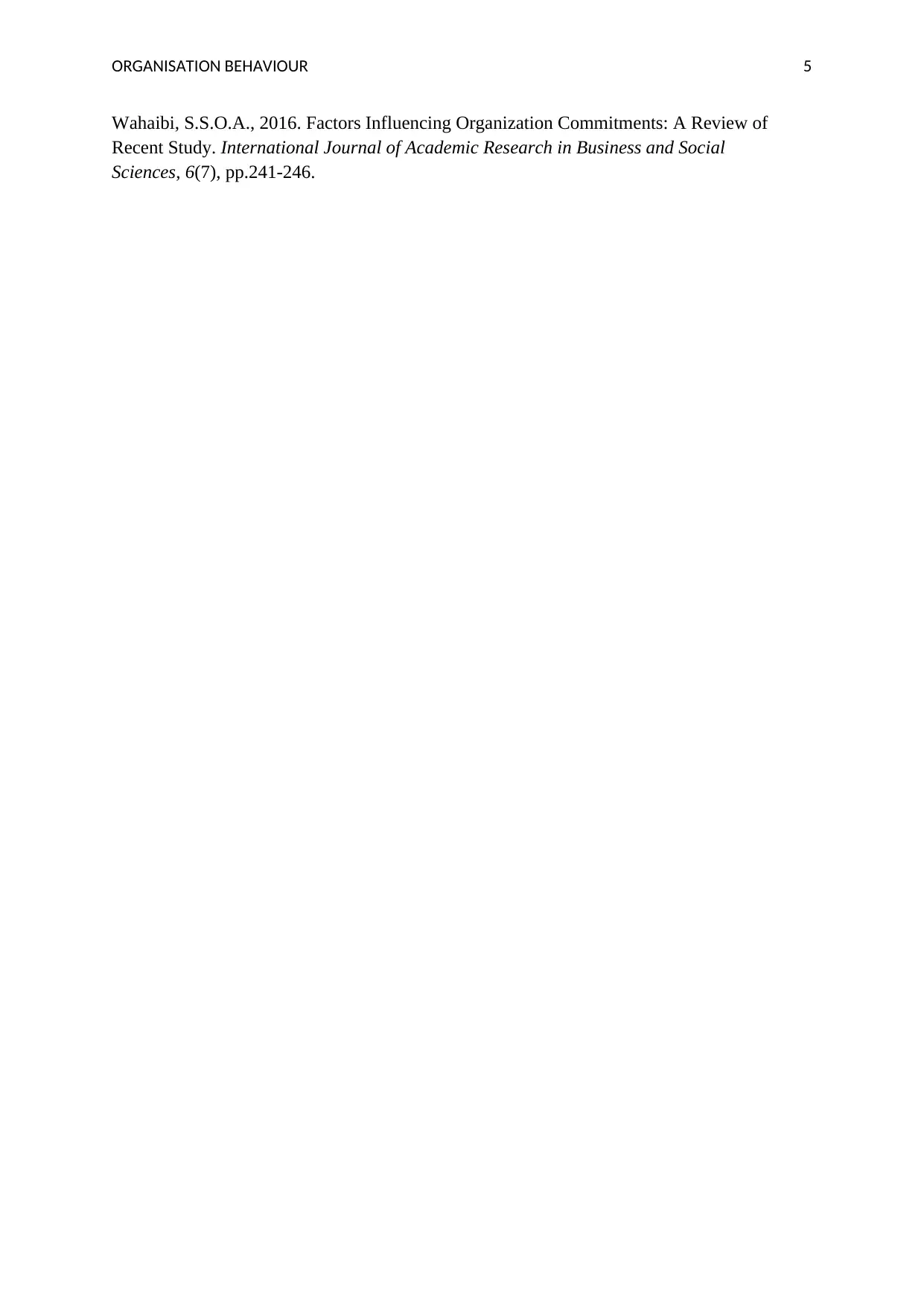
ORGANISATION BEHAVIOUR 5
Wahaibi, S.S.O.A., 2016. Factors Influencing Organization Commitments: A Review of
Recent Study. International Journal of Academic Research in Business and Social
Sciences, 6(7), pp.241-246.
Wahaibi, S.S.O.A., 2016. Factors Influencing Organization Commitments: A Review of
Recent Study. International Journal of Academic Research in Business and Social
Sciences, 6(7), pp.241-246.
⊘ This is a preview!⊘
Do you want full access?
Subscribe today to unlock all pages.

Trusted by 1+ million students worldwide
1 out of 6
Related Documents
Your All-in-One AI-Powered Toolkit for Academic Success.
+13062052269
info@desklib.com
Available 24*7 on WhatsApp / Email
![[object Object]](/_next/static/media/star-bottom.7253800d.svg)
Unlock your academic potential
Copyright © 2020–2025 A2Z Services. All Rights Reserved. Developed and managed by ZUCOL.





